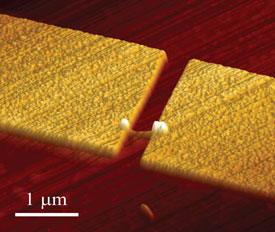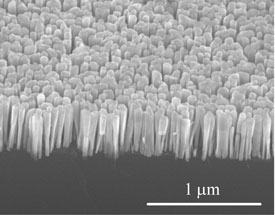- News
12 April 2013
Michigan demos simpler, more efficient single-photon emitter for quantum cryptography
In a development that could make the advanced form of secure communications known as quantum cryptography more practical, University of Michigan researchers – supported by the US National Science Foundation (NSF) - have demonstrated a simpler, more efficient single-photon emitter that can be made using traditional semiconductor processing techniques (‘Electrically-driven polarized single-photon emission from an InGaN quantum dot in a GaN nanowire’, published online in Nature Communications on 9 April; doi:10.1038/ncomms2691).
Single-photon emitters are essential for quantum cryptography, which keeps data secure by using the so-called observer effect: the act of an eavesdropper listening in jumbles the message, since in the quantum realm observing a system always changes it. For quantum cryptography to work, it's necessary to encode the message just one photon at a time. The sender and the recipient will hence know whether anyone has tampered with the message.
While the University of Michigan researchers didn't make the first single-photon emitter, they claim that their new device- which was fabricated at the University of Michigan Lurie Nanofabrication Facility - improves on the existing technology and is much easier to make.
 Picture: Atomic-force microscope (AFM) image of nanowire single-photon emitter. (Courtesy of Pallab Bhattacharya.)
Picture: Atomic-force microscope (AFM) image of nanowire single-photon emitter. (Courtesy of Pallab Bhattacharya.)
“It is all based on silicon,” says project leader Pallab Bhattacharya, the Charles M. Vest Distinguished University Professor of Electrical Engineering and Computer Science, and the James R. Mellor Professor of Engineering. Bhattacharya is co-author of the paper. The first author is Saniya Deshpande, a graduate student in electrical engineering and computer science.
The new single-photon emitter is a single nanowire made of gallium nitride with a very small region of indium gallium nitride (InGaN) that behaves as a quantum dot. The researchers grew the nanowires on a silicon substrate. Because the technique is silicon-based, the infrastructure to manufacture the emitters on a larger scale already exists. “It produces the pathway to realizing a practical electrically injected single-photon emitter,” Bhattacharya says.
 Picture: Nanowires growing on silicon. (Courtesy of Pallab Bhattacharya.)
Picture: Nanowires growing on silicon. (Courtesy of Pallab Bhattacharya.)
Key enablers of the new technology are size and compactness. “By making the diameter of the nanowire very small and by altering the composition over a very small section of it, a quantum dot is realized,” Bhattacharya says. “The quantum dot emits single-photons upon electrical excitation.”
The University of Michigan emitter is electrically rather than optically pumped, helping to make it more practical. Each photon it emits has the same degree of linear polarization. Most other single-photon emitters release light particles with a random polarization. “Half might have one polarization and the other half might have the other," Bhattacharya says. “So in cryptic message, if you want to code them, you would only be able to use 50% of the photons. With our device, you could use almost all of them."
The device operates at cold temperatures, but the researchers are working on one that operates closer to room temperature.
www.nature.com/ncomms/journal/v4/n4/full/ncomms2691.html



